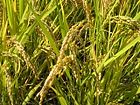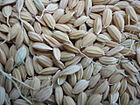Note: This is a project under development. The articles on this wiki are just being initiated and broadly incomplete. You can Help creating new pages.
Difference between revisions of "Oryza sativa - Dhanya"
(→External Links) |
|||
| Line 1: | Line 1: | ||
[[File:Oryza sativa - Köhler–s Medizinal-Pflanzen-232.jpg|thumb|right|''Dhanya'', ''Oryza sativa'']] | [[File:Oryza sativa - Köhler–s Medizinal-Pflanzen-232.jpg|thumb|right|''Dhanya'', ''Oryza sativa'']] | ||
| − | ''' | + | '''Oryza sativa''' rice is an erect, usually annual grass though there are also perennial forms. It varies considerably in height and habit according to variety with cultivars ranging from 30 - 180cm tall. Rice has been cultivated in India and China for at least 4,000 years. It is one of the most commonly cultivated crops in the world, being grown for its edible seed in tropical to warm temperate climates around the world and forming a staple food for about half the world's human population. |
| − | |||
==Uses== | ==Uses== | ||
| − | {{Uses|Stomach disorders}} | + | {{Uses|Stomach disorders}}.<ref name="Uses"/> |
| − | <ref name="Uses"/> | ||
==Parts Used== | ==Parts Used== | ||
| − | {{Parts Used|Root}}, {{Parts Used|Seeds}} | + | {{Parts Used|Root}}, {{Parts Used|Seeds}}. |
==Chemical Composition== | ==Chemical Composition== | ||
==Common names== | ==Common names== | ||
| − | {{Common names|kn= | + | {{Common names|kn=Akki, Bhattha, Nellu|ml=Ari, Navaranellu, Nellu|sa=Dhanya, Khanjarita, Sastika, Vilavasin|ta=Arisi, Nellu|te=Biyyam, Vudlu|hi=Chaval, Dhan|en=Rice}}. |
<ref name="Common names"/> | <ref name="Common names"/> | ||
| Line 36: | Line 34: | ||
==Identification== | ==Identification== | ||
===Leaf=== | ===Leaf=== | ||
| − | {{Leaf|Simple| | + | {{Leaf|Simple|Alternate|Culms 50-120 cm high, erect, rooting at the lower nodes; nodes glabrous.}}<ref name="Leaf"/> |
===Flower=== | ===Flower=== | ||
| − | {{Flower|Bisexual| | + | {{Flower|Bisexual|Panicle|Pale yellow|10|10-25 cm long, lax. Spikelets 7-10 mm long, oblong, awned or not. Glumes reduced. First lemma 7-10 mm long, oblong-lanceolate, empty.}} |
===Fruit=== | ===Fruit=== | ||
| − | {{Fruit|Grain|| | + | {{Fruit|Grain||Oblong, tightly enclosed by the lemma and palea||}} |
===Other features=== | ===Other features=== | ||
| Line 73: | Line 71: | ||
File:Unhulled rice.jpg | File:Unhulled rice.jpg | ||
File:Ricegrains1500ppx.jpg | File:Ricegrains1500ppx.jpg | ||
| − | |||
| − | |||
</gallery> | </gallery> | ||
| Line 80: | Line 76: | ||
<references> | <references> | ||
| − | <ref name="Uses">[https://www.entranceindia.com/medicinal-plants-herbs-flowers/sali-fruit-in-ayurveda-botanical-name-oryza-sativa-linn/ | + | <ref name="Uses">[https://www.entranceindia.com/medicinal-plants-herbs-flowers/sali-fruit-in-ayurveda-botanical-name-oryza-sativa-linn/ Uses]</ref> |
| − | <ref name="Leaf">[http://FLOWERING PLANTS OF KERALA VER.2, N. Sasidharan | + | <ref name="Leaf">[http://FLOWERING PLANTS OF KERALA VER.2, N. Sasidharan BOTANIC DESCRIPTION]</ref> |
| − | <ref name="Common names">[http://envis.frlht.org/bot_search | + | <ref name="Common names">[http://envis.frlht.org/bot_search Vernacular names]</ref> |
Revision as of 15:40, 10 June 2020
Oryza sativa rice is an erect, usually annual grass though there are also perennial forms. It varies considerably in height and habit according to variety with cultivars ranging from 30 - 180cm tall. Rice has been cultivated in India and China for at least 4,000 years. It is one of the most commonly cultivated crops in the world, being grown for its edible seed in tropical to warm temperate climates around the world and forming a staple food for about half the world's human population.
Contents
- 1 Uses
- 2 Parts Used
- 3 Chemical Composition
- 4 Common names
- 5 Properties
- 6 Habit
- 7 Identification
- 8 List of Ayurvedic medicine in which the herb is used
- 9 Where to get the saplings
- 10 Mode of Propagation
- 11 How to plant/cultivate
- 12 Commonly seen growing in areas
- 13 Photo Gallery
- 14 References
- 15 External Links
Uses
Parts Used
Chemical Composition
Common names
| Language | Common name |
|---|---|
| Kannada | Akki, Bhattha, Nellu |
| Hindi | Chaval, Dhan |
| Malayalam | Ari, Navaranellu, Nellu |
| Tamil | Arisi, Nellu |
| Telugu | Biyyam, Vudlu |
| Marathi | NA |
| Gujarathi | NA |
| Punjabi | NA |
| Kashmiri | NA |
| Sanskrit | Dhanya, Khanjarita, Sastika, Vilavasin |
| English | Rice |
. [2]
Properties
Reference: Dravya - Substance, Rasa - Taste, Guna - Qualities, Veerya - Potency, Vipaka - Post-digesion effect, Karma - Pharmacological activity, Prabhava - Therepeutics.
Dravya
Rasa
Madhura (Sweet), Kashaya (Astringent)
Guna
Laghu (Light), Snighdha (Slimy)
Veerya
Sheeta (cold)
Vipaka
Madhura (Sweet)
Karma
Pitta
Prabhava
Habit
Identification
Leaf
| Kind | Shape | Feature |
|---|---|---|
| Simple | Alternate | Culms 50-120 cm high, erect, rooting at the lower nodes; nodes glabrous. |
Flower
| Type | Size | Color and composition | Stamen | More information |
|---|---|---|---|---|
| Bisexual | Panicle | Pale yellow | 10 | 10-25 cm long, lax. Spikelets 7-10 mm long, oblong, awned or not. Glumes reduced. First lemma 7-10 mm long, oblong-lanceolate, empty. |
Fruit
| Type | Size | Mass | Appearance | Seeds | More information |
|---|---|---|---|---|---|
| Grain | Oblong, tightly enclosed by the lemma and palea | {{{6}}} |
Other features
List of Ayurvedic medicine in which the herb is used
Where to get the saplings
Mode of Propagation
How to plant/cultivate
Season to grow
Soil type
Propagation
Commonly seen growing in areas
Tropical area, Sub tropical area
Photo Gallery
References
External Links
- Ayurvedic Herbs known to be helpful to treat Stomach disorders
- Herbs with Root used in medicine
- Herbs with Seeds used in medicine
- Herbs with common name in Kannada
- Herbs with common name in Hindi
- Herbs with common name in Malayalam
- Herbs with common name in Tamil
- Herbs with common name in Telugu
- Herbs with common name in Sanskrit
- Herbs with common name in English
- Habit - Herb
- Index of Plants which can be propagated by Seeds
- Herbs that are commonly seen in the region of Tropical area
- Herbs that are commonly seen in the region of Sub tropical area
- Herbs
- Poaceae





